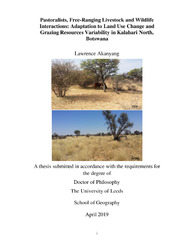| dc.description.abstract | Conservation of African wildlife is dependent on conservation areas (CAs) and adjacent pastoral areas. Even though the number of African CAs are increasing, the wildlife population in these CAs are in general decline because they are small and isolated. With human population densities, settlements and livestock grazing pressure in communally managed pastoral areas (hereafter CGAs) adjacent to CAs increasing, CGAs have become fragmented and degraded. Increasing interaction between livestock and wildlife between CAs and CGAs is inevitable. While there is some knowledge of the positive and negative interactions between wildlife moving between CAs and livestock in pastoral areas (e.g. Mara and Serengeti regions), less is known about such interactions in free-ranging pastoral systems in the Kalahari. This study therefore, investigates interaction – specifically the levels of competition and facilitation – between livestock and wildlife and how this varies between the wet and dry season and wildlife body size functional grouping and predation risk in the Kalahari. The study analysed the spatial distribution of forage availability and vegetation heterogeneity, the spatial distribution of eleven herbivores and twelve carnivores of different body sizes (>1kg) in relation to pastoral activities, and disturbance along a livestock grazing gradient starting in CGAs and ending in CAs in the Kalahari. The study used a systematic sampling approach to survey vegetation and wildlife spoor/tracks, in addition to conducting road-side field observations and Global Positioning System telemetry. The study shows that pastoral activities are largely confined to the CGAs, within a radius of 15km from the main settlements. Free-ranging livestock reduced forage quality and quantity in both seasons studied and facilitated woody plants, forbs, unpalatable annual grasses within the 15km radius from the settlements. Large-sized herbivores and carnivores concentrated in CAs and avoided areas in CGAs impacted by pastoralism in both seasons. Medium-sized carnivores and herbivores, except Ostrich, avoided areas of high livestock grazing intensity in pastoral dominated areas and were associated with CAs and moderately grazed areas in CGAs in both seasons. Small-sized wild herbivores, except Springbok, were associated with CGAs even closer to settlements in both seasons. These results suggest that even though the pastoral areas near the CAs are important as seasonal dispersal and breeding grounds for wildlife, intensified pastoral activities, such increased livestock grazing intensity and pastoralist-induced risk in the CGAs are restricting the seasonal movements of medium to large-sized wildlife between the CAs and the adjacent CGAs. Hence it is essential for wildlife conservation efforts to focus on 1) securing the dispersal areas (i.e. CGAs) by promoting moderate livestock grazing intensity and reducing pastoralist-induced risk to attract medium to large wildlife and 2) create and maintain functional heterogeneity in CAs to attract small sized wildlife. | en_US |

